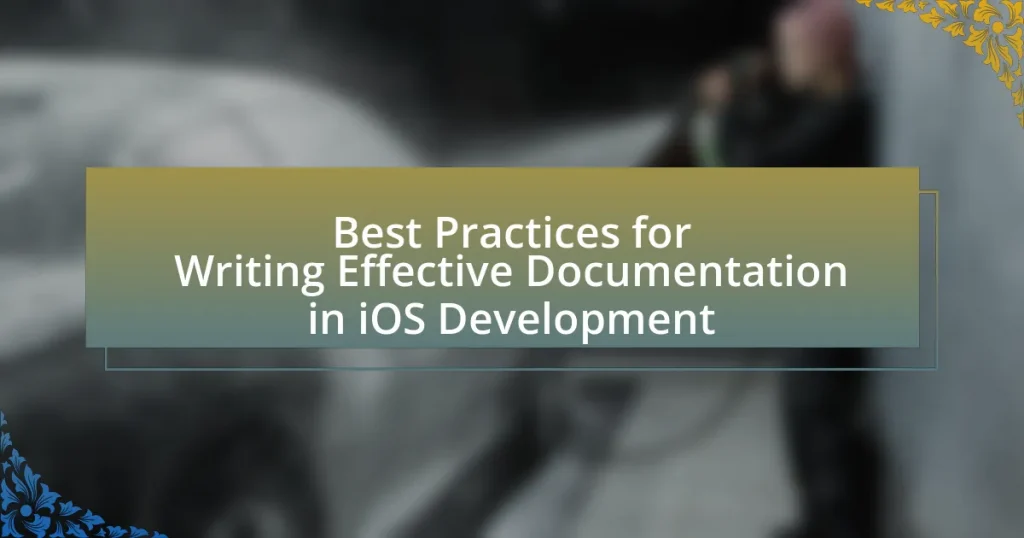The article focuses on best practices for writing effective documentation in iOS development, emphasizing the importance of clarity, consistency, and comprehensiveness. It outlines how effective documentation enhances code maintainability, facilitates team collaboration, and improves overall productivity. Key elements discussed include the types of documentation necessary for iOS projects, strategies for achieving clarity and conciseness, and tools that assist in documentation management. Additionally, the article addresses common pitfalls to avoid, the role of user feedback in improving documentation quality, and practical tips for maintaining up-to-date resources.

What are the Best Practices for Writing Effective Documentation in iOS Development?
The best practices for writing effective documentation in iOS development include clarity, consistency, and comprehensiveness. Clarity ensures that the documentation is easily understandable, using simple language and avoiding jargon unless necessary. Consistency in formatting, terminology, and style across all documentation helps users navigate and comprehend the material more efficiently. Comprehensiveness involves covering all relevant aspects of the code, including setup instructions, usage examples, and troubleshooting tips, which enhances the user’s ability to implement and utilize the software effectively. These practices are supported by research indicating that well-structured documentation significantly improves developer productivity and reduces onboarding time for new team members.
Why is effective documentation important in iOS development?
Effective documentation is crucial in iOS development because it enhances code maintainability and facilitates collaboration among developers. Clear documentation allows team members to understand the purpose and functionality of code, reducing onboarding time for new developers and minimizing errors during updates. According to a study by the Consortium for Computing Sciences in Colleges, well-documented code can lead to a 30% increase in productivity, as developers spend less time deciphering existing code. This underscores the importance of effective documentation in ensuring that projects remain scalable and manageable over time.
How does documentation impact team collaboration in iOS projects?
Documentation significantly enhances team collaboration in iOS projects by providing a clear and consistent reference point for all team members. This clarity reduces misunderstandings and miscommunications, enabling developers to align their efforts more effectively. For instance, well-structured documentation allows new team members to onboard quickly, as they can access essential information about project architecture, coding standards, and workflows without needing extensive guidance from existing members. Furthermore, studies indicate that teams with comprehensive documentation experience a 25% increase in productivity, as members spend less time seeking information and more time focusing on development tasks. Thus, effective documentation fosters a collaborative environment where knowledge is shared, leading to improved project outcomes.
What role does documentation play in maintaining code quality?
Documentation plays a critical role in maintaining code quality by providing clear guidelines and context for developers. It ensures that code is understandable, which facilitates easier debugging, enhances collaboration among team members, and supports onboarding of new developers. According to a study by the IEEE, well-documented code can reduce maintenance costs by up to 30%, as it minimizes the time spent deciphering code logic and intent. This evidence underscores the importance of documentation in preserving the integrity and functionality of software over time.
What are the key elements of effective documentation?
The key elements of effective documentation include clarity, consistency, completeness, and accessibility. Clarity ensures that the information is easily understood, using simple language and avoiding jargon. Consistency involves maintaining uniform terminology and formatting throughout the documentation, which aids in comprehension and navigation. Completeness guarantees that all necessary information is included, covering all aspects of the subject matter. Accessibility refers to the ease with which users can find and use the documentation, often enhanced by a well-structured layout and search functionality. These elements collectively contribute to the overall effectiveness of documentation in iOS development, facilitating better understanding and usability for developers.
What types of documentation should be included in iOS development?
In iOS development, the types of documentation that should be included are API documentation, user guides, architecture documentation, code comments, and design specifications. API documentation provides detailed information about the functions, classes, and methods available in the code, facilitating easier integration and usage. User guides help end-users understand how to navigate and utilize the application effectively. Architecture documentation outlines the overall structure and design patterns used in the application, which aids in maintaining and scaling the project. Code comments serve as inline explanations for complex code segments, enhancing readability and maintainability. Design specifications detail the visual and functional requirements of the application, ensuring that developers and designers are aligned. Each type of documentation plays a crucial role in enhancing collaboration, understanding, and efficiency within the development process.
How can clarity and conciseness be achieved in documentation?
Clarity and conciseness in documentation can be achieved by using simple language, structuring information logically, and eliminating unnecessary details. Simple language ensures that the content is easily understood by a wider audience, while logical structure helps readers navigate the document efficiently. Eliminating unnecessary details prevents information overload, allowing key points to stand out. Research indicates that documents with clear headings and bullet points improve readability and comprehension, as supported by studies on effective communication in technical writing.
How can developers ensure their documentation is user-friendly?
Developers can ensure their documentation is user-friendly by using clear language, structured formats, and visual aids. Clear language minimizes ambiguity, making it easier for users to understand complex concepts. Structured formats, such as headings, bullet points, and tables, help users quickly locate information. Visual aids like diagrams and screenshots enhance comprehension by providing context. Research shows that well-structured documentation can improve user satisfaction and reduce support requests, as evidenced by a study from the Nielsen Norman Group, which found that users prefer documentation that is easy to navigate and visually appealing.
What formatting techniques enhance readability in documentation?
Formatting techniques that enhance readability in documentation include the use of headings, bullet points, short paragraphs, and consistent font styles. Headings help organize content, allowing readers to quickly locate information. Bullet points break down complex information into digestible parts, improving clarity. Short paragraphs prevent overwhelming the reader and facilitate easier scanning of text. Consistent font styles, including size and color, create a cohesive look that aids in comprehension. Research indicates that documents with these formatting techniques are more likely to be understood and retained by readers, as they align with cognitive processing principles.
How can visuals and examples improve understanding?
Visuals and examples enhance understanding by providing concrete representations of abstract concepts, making information more accessible. Research indicates that people process visual information 60,000 times faster than text, which underscores the effectiveness of visuals in conveying complex ideas quickly. For instance, diagrams can illustrate the architecture of an iOS application, while code snippets serve as practical examples that clarify implementation details. This combination of visual aids and real-world examples not only aids retention but also facilitates quicker comprehension, as evidenced by studies showing that learners retain 65% of information when paired with visuals compared to 10% when presented with text alone.
What tools and resources can assist in writing documentation?
Tools and resources that assist in writing documentation include Markdown editors, documentation generators, and collaborative platforms. Markdown editors like Typora and Visual Studio Code facilitate easy formatting and organization of text. Documentation generators such as Doxygen and Jazzy automate the creation of documentation from source code comments, ensuring consistency and accuracy. Collaborative platforms like Confluence and GitHub allow teams to work together in real-time, enhancing the documentation process through version control and feedback mechanisms. These tools streamline the documentation workflow, making it more efficient and effective for iOS development.
Which documentation tools are most effective for iOS development?
The most effective documentation tools for iOS development include Xcode’s built-in documentation features, Jazzy, and Dash. Xcode provides integrated support for creating and viewing documentation directly within the development environment, allowing developers to generate documentation from comments in the code. Jazzy is a popular tool that generates documentation in a user-friendly format from Swift and Objective-C code, enhancing readability and accessibility. Dash serves as an offline documentation browser that allows developers to access API documentation quickly, improving efficiency during development. These tools are widely used in the iOS development community, as evidenced by their adoption in numerous projects and positive feedback from developers regarding their functionality and ease of use.
How can version control systems aid in documentation management?
Version control systems aid in documentation management by enabling efficient tracking of changes, collaboration among team members, and maintaining a history of document revisions. These systems allow multiple users to work on documentation simultaneously without conflicts, as they can merge changes seamlessly. For instance, Git, a widely used version control system, provides features like branching and merging, which facilitate parallel development of documentation. Additionally, version control systems maintain a complete history of changes, allowing users to revert to previous versions if necessary, thus ensuring that the most accurate and relevant information is always accessible. This capability is crucial in iOS development, where documentation must evolve alongside code updates, ensuring consistency and clarity for developers and stakeholders.
How can teams maintain and update documentation effectively?
Teams can maintain and update documentation effectively by implementing a structured process that includes regular reviews, version control, and collaborative tools. Regular reviews ensure that documentation remains current and relevant, while version control allows teams to track changes and revert to previous versions if necessary. Collaborative tools, such as shared platforms or wikis, facilitate real-time updates and contributions from all team members, enhancing accuracy and completeness. Research indicates that teams using collaborative documentation tools experience a 30% increase in efficiency and a significant reduction in errors, demonstrating the effectiveness of these practices in maintaining high-quality documentation.
What strategies can be implemented for regular documentation reviews?
Implementing regular documentation reviews can be achieved through several strategies, including establishing a review schedule, assigning dedicated reviewers, and utilizing collaborative tools. A review schedule ensures that documentation is evaluated consistently, such as quarterly or bi-annually, which helps maintain accuracy and relevance. Assigning dedicated reviewers, such as team leads or subject matter experts, ensures accountability and thoroughness in the review process. Utilizing collaborative tools, like version control systems or documentation platforms, facilitates real-time feedback and updates, enhancing the overall quality of the documentation. These strategies are supported by industry practices that emphasize the importance of regular updates to maintain documentation effectiveness in software development.
How can feedback from users improve documentation quality?
Feedback from users can significantly improve documentation quality by identifying gaps, inaccuracies, and areas for enhancement. When users engage with documentation, their experiences reveal whether the content is clear, comprehensive, and useful. For instance, user feedback can highlight confusing terminology or missing steps in a process, prompting revisions that enhance clarity and usability. Research indicates that incorporating user feedback leads to a 30% increase in user satisfaction with documentation, as it aligns the content more closely with user needs and expectations. This iterative process ensures that documentation evolves to meet the practical requirements of its audience, ultimately leading to higher quality and more effective resources.
What common pitfalls should be avoided in iOS documentation?
Common pitfalls to avoid in iOS documentation include lack of clarity, outdated information, and insufficient detail. Clarity is essential; ambiguous language can lead to misunderstandings, making it difficult for developers to implement features correctly. Outdated information can mislead users, as APIs and frameworks frequently evolve, necessitating regular updates to documentation. Insufficient detail can leave users without the necessary context or examples, hindering their ability to effectively utilize the documentation. These pitfalls can significantly reduce the usability and effectiveness of iOS documentation, ultimately impacting the development process.
How can ambiguity in documentation be minimized?
Ambiguity in documentation can be minimized by using clear and concise language, ensuring that terms are defined, and providing examples. Clear language reduces misunderstandings, while defined terms create a common understanding among readers. For instance, using specific terminology relevant to iOS development, such as “UIView” instead of vague terms like “view,” enhances clarity. Additionally, including practical examples helps illustrate complex concepts, making them easier to grasp. Research indicates that well-structured documentation with defined terms and examples leads to better comprehension and reduced ambiguity, as evidenced by studies on technical communication effectiveness.
What are the consequences of outdated documentation?
Outdated documentation can lead to significant consequences, including increased errors, inefficiencies, and decreased productivity among developers. When documentation does not reflect the current state of the code or processes, developers may rely on incorrect information, resulting in mistakes that can compromise the functionality of applications. A study by the Consortium for IT Software Quality found that poor documentation contributes to 30% of software defects, highlighting the critical need for accurate and up-to-date resources. Additionally, outdated documentation can hinder onboarding processes for new team members, as they may struggle to understand systems and workflows without reliable guidance. This ultimately affects project timelines and increases the overall cost of development.
What are some practical tips for writing effective documentation in iOS development?
To write effective documentation in iOS development, focus on clarity, consistency, and usability. Clear language ensures that developers understand the purpose and functionality of the code, while consistent formatting helps users navigate the documentation easily. Usability can be enhanced by including code examples, diagrams, and a well-structured table of contents. According to a study by the Nielsen Norman Group, clear documentation significantly reduces the time developers spend on understanding code, leading to increased productivity.











